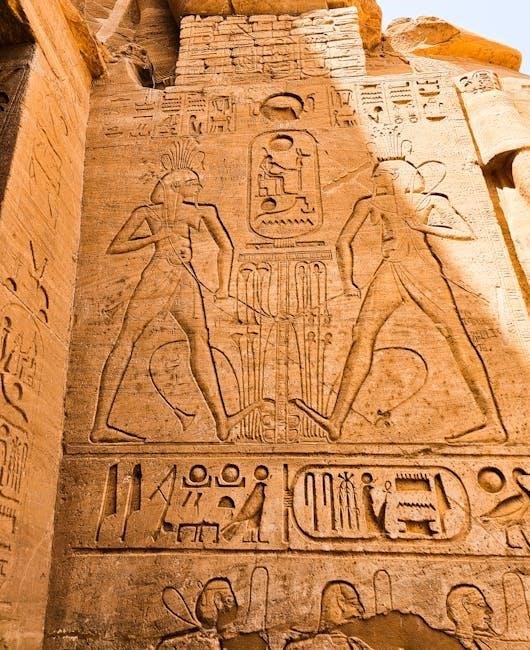Inscription in Cataclysm is a crafting profession that transforms herbs into powerful inks and glyphs‚ enhancing class abilities and providing valuable items for players. Herbalism is its primary counterpart‚ enabling the creation of essential materials. This profession is crucial for both PvE and PvP‚ offering customization through glyphs and boosting gameplay efficiency. Players can craft items like Fortune Cards and Darkmoon Decks‚ which are highly sought after in the game economy.
1.1 What is Inscription?
Inscription is a crafting profession in World of Warcraft: Cataclysm that focuses on creating inks‚ glyphs‚ and other items by milling herbs. As a profession‚ it allows players to transform raw materials like herbs into powerful tools that enhance gameplay. Glyphs‚ for instance‚ are inscribed items that modify class abilities‚ providing customization and improvement to spells or talents. Inscription also enables the creation of Fortune Cards and Darkmoon Decks‚ which are highly sought after for their unique bonuses. This profession is deeply tied to Herbalism‚ as herbs are the primary resource used to craft inks. Inscription offers versatility‚ making it valuable for both PvE and PvP players seeking to optimize their characters’ performance.

1.2 Importance of Inscription in Cataclysm
Inscription is a vital profession in World of Warcraft: Cataclysm‚ offering unique benefits that enhance gameplay. By crafting glyphs‚ players can customize and improve class abilities‚ providing a competitive edge in both PvE and PvP. Glyphs allow for tailored playstyles‚ making Inscription a cornerstone for character optimization. Additionally‚ Inscription enables the creation of Fortune Cards and Darkmoon Decks‚ which grant exclusive bonuses and are highly sought after by players. This profession also complements Herbalism‚ as herbs are the primary resource for crafting inks. Mastery of Inscription not only boosts character performance but also opens lucrative opportunities for gold-making through the sale of inks and glyphs‚ making it a valuable skill for any player seeking to excel in Cataclysm.
1.3 Brief Overview of the Leveling Process
Leveling Inscription in Cataclysm involves crafting various inks and glyphs‚ with a focus on efficiency and material optimization. The process begins with milling herbs to create basic inks‚ which are used to craft low-level glyphs. As you progress‚ you’ll unlock more complex recipes‚ including Fortune Cards and Darkmoon Decks‚ which require higher-level materials. The journey from 1 to 525 is divided into distinct phases‚ with key milestones at levels 75‚ 150‚ 225‚ and 300. Each phase introduces new recipes and challenges‚ requiring players to adapt their crafting strategies. By following a structured approach and prioritizing essential crafts‚ you can efficiently level your Inscription skill while minimizing costs and maximizing profitability.

Materials and Tools Needed for Inscription
Inscription requires herbs‚ inks‚ and pigments to craft glyphs‚ inks‚ and other items. Essential tools include the Inscription Set and a milling tool for processing herbs into pigments.
2.1 Herbs Required for Inscription
Inscription relies on specific herbs to create inks and pigments. Common herbs include Ashen Pigment‚ derived from Whiptail and Twilight Jasmine‚ and Inferno Ink‚ made from Firebloom and Cinderbloom. Higher-level herbs like Blackthorn and Stormvine are used for advanced inks.
These herbs are gathered through Herbalism‚ a complementary profession. Players can either farm these herbs themselves or purchase them from the Auction House. Ashen Pigment is particularly crucial for crafting early inks‚ while Inferno Ink becomes essential for higher-level recipes. Efficient herb usage is key to minimizing crafting costs and progressing smoothly through the leveling process.
2.2 Inks and Pigments
Inscription relies heavily on the creation of inks and pigments‚ which are crafted from specific herbs. Key inks include Ashen Pigment‚ made from Whiptail and Twilight Jasmine‚ and Inferno Ink‚ crafted from Firebloom and Cinderbloom. These inks are essential for creating glyphs‚ scrolls‚ and other Inscription items. Higher-level inks‚ such as Blackthorn and Stormvine‚ are used in advanced recipes. Pigments are the base materials for inks and are obtained through milling herbs. Having a steady supply of inks is crucial for both leveling and crafting profitable items.
Inks and pigments form the foundation of Inscription‚ enabling players to craft powerful glyphs and other valuable items in Cataclysm Classic.
2.3 Other Crafting Materials
Beyond herbs and inks‚ Inscription requires additional materials to craft advanced items. Parchment is a fundamental material used for creating glyphs‚ scrolls‚ and cards. Players can purchase parchment from vendors or craft it using other Profession skills. Rare materials like Leather and Volatile Elements are occasionally needed for high-level recipes. Pigments‚ obtained through milling‚ are also essential for creating specific inks. Additionally‚ certain crafted items‚ such as Darkmoon Cards‚ require unique materials like Ink of the Sea and Nether Pigment. Staying stocked with these materials ensures efficient crafting and progression in Inscription.

Leveling Inscription from 1 to 525
Leveling Inscription involves crafting various inks and glyphs‚ starting with lower-level materials and progressing through each expansion’s recipes. The process is divided into stages‚ each requiring specific herbs and techniques to optimize material use and skill progression‚ ultimately reaching the Cataclysm cap of 525.
3.1 Leveling from 1 to 75: The Basics
Starting at level 1‚ Inscription focuses on creating basic inks and glyphs. Begin by milling herbs like Cinderbloom and Stormvine to produce Midnight Ink and Shadeblood Pigment. Craft Minor Glyphs and Scrolls to gain initial experience. As you progress‚ switch to Blackthorn and Earthroot for higher-level inks. Keep a steady supply of herbs by pairing Inscription with Herbalism. Focus on mass-producing inks to quickly gain skill points. Avoid crafting unnecessary items to save materials. By level 75‚ you’ll have mastered the foundational recipes‚ setting you up for more complex crafting in later stages. Optimize your material usage to ensure a smooth transition to intermediate levels.
3.2 Leveling from 75 to 150: Intermediate Crafting
At level 75‚ Inscription shifts to intermediate recipes‚ focusing on higher-tier inks and glyphs. Begin by milling Whiptail and Grave Moss to produce Dawnstar Ink and Crimson Pigment. Craft Glyph of Shadow Walk for Rogues and Glyph of Power Word: Shield for Priests‚ as these are in high demand. Continue creating Fortune Cards to boost experience gains. As you progress‚ experiment with Card of Omens and Card of Destiny for additional skill points. Optimize material usage by crafting only what is necessary. By level 150‚ you’ll have access to more complex recipes‚ allowing you to refine your crafting skills further. This phase lays the groundwork for advanced Inscription techniques in later levels.
3.3 Leveling from 150 to 225: Advanced Techniques
Reaching level 150 marks the transition to advanced Inscription techniques. Focus on crafting high-demand glyphs like Glyph of Evocation for Mages and Glyph of Metamorphosis for Warlocks. Begin milling Firebloom and Purple Lotus to produce Burning Ink‚ a key component for higher-level recipes. Create Glyph of Power Word: Barrier for Priests and Glyph of Raptor Strike for Hunters‚ which are consistently in demand. Continue crafting Darkmoon Cards‚ as they provide significant experience gains. By level 225‚ you’ll unlock more complex recipes‚ enabling you to craft powerful glyphs and inks that are essential for endgame content. This phase requires careful material management to optimize skill progression.
3.4 Leveling from 225 to 300: Expert Recipes
At level 225‚ Inscription progresses to expert recipes‚ focusing on high-demand glyphs and inks. Craft glyphs like Glyph of Shadow Word: Pain for Priests and Glyph of Trap Mastery for Hunters‚ which are highly sought after. Use Cinderbloom and Stormvine to mill Inferno Ink‚ essential for advanced recipes. Continue crafting Darkmoon Cards to gain consistent experience. This phase introduces more complex glyph recipes‚ requiring precise material management. Prioritize crafting glyphs with high demand on the Auction House to optimize leveling efficiency. By reaching level 300‚ you’ll unlock master-level recipes‚ further enhancing your crafting capabilities and profitability in the game economy.
3.5 Leveling from 300 to 375: Artisan Recipes
Reaching level 300 unlocks Artisan recipes‚ which focus on advanced glyphs and high-value items. Use Whiptail and Icethorn to craft Midnight Ink‚ essential for glyphs like Glyph of Crusader Strike for Paladins and Glyph of Immolate for Warlocks. This phase introduces Mysterious Fortune Cards‚ which are valuable for crafting Darkmoon Decks. Prioritize glyphs with high demand on the Auction House to maximize profit while leveling. Crafting Glyph of Shadowbolt for Warlocks and Glyph of Rupture for Rogues is particularly effective. By reaching 375‚ you’ll gain access to master-level recipes‚ further enhancing your crafting efficiency and market competitiveness in Cataclysm Classic.
3.6 Leveling from 375 to 450: Master Recipes
At level 375‚ Inscription unlocks master recipes‚ focusing on high-end glyphs and specialty items. Use Whiptail and Icethorn to craft Midnight Ink‚ essential for powerful glyphs like Glyph of Crusader Strike for Paladins and Glyph of Immolate for Warlocks. This phase also introduces Mysterious Fortune Cards‚ which are key components for crafting Darkmoon Decks‚ highly sought after by players. Focus on glyphs with high demand‚ such as Glyph of Shadowbolt for Warlocks and Glyph of Rupture for Rogues. By reaching level 450‚ you’ll be well-prepared to transition into Cataclysm-specific recipes‚ ensuring your Inscription skill remains competitive in the evolving game economy.
3.7 Leveling from 450 to 525: Cataclysm Recipes
Reaching level 450 unlocks Cataclysm-specific recipes‚ focusing on high-demand glyphs and advanced items. Craft Blackfallow Ink using Ashen Pigment to create glyphs like Glyph of Unleavened Bread for Paladins and Glyph of Life Tap for Warlocks. This phase emphasizes Mysterious Fortune Cards‚ which are combined to create Darkmoon Decks‚ highly valuable for players. Prioritize glyphs with consistent demand‚ such as Glyph of Scourge Strike for Death Knights and Glyph of Steady Shot for Hunters. By strategically crafting these items‚ you’ll efficiently reach 525‚ completing your Inscription journey and preparing for high-end crafting and profit opportunities in the Cataclysm economy.

Optimizing Crafting Costs
Minimize expenses by buying herbs in bulk‚ using the Auction House wisely‚ and crafting glyphs with the highest demand. Plan recipes to reduce material waste and maximize profit margins while leveling;
4.1 Using Auction House to Buy Materials
Utilize the Auction House strategically to acquire herbs and materials at competitive prices. Compare prices across different sellers to ensure cost-effectiveness. Consider buying in bulk during off-peak hours when demand is lower. Use addons like TSM or Auctionator to track market trends and automate purchases. Avoid overpaying for materials by setting a budget and sticking to it. Additionally‚ create a spreadsheet to calculate the best prices for herbs versus inks‚ ensuring you maximize profit margins. Timing your purchases can significantly reduce crafting costs‚ especially for high-demand materials like Blackfallow Ink and Ashen Pigment. This approach ensures efficient material sourcing while leveling your Inscription skill.
4.2 Farming Herbs Efficiently
Farming herbs efficiently is crucial for Inscription‚ as it reduces reliance on the Auction House and saves gold. Focus on gathering high-demand herbs like Cinderbloom and Stormvine in zones such as Mount Hyjal and Twilight Highlands. Use your Herbalism skill to locate nodes quickly and avoid competition by farming during off-peak hours. A fast mount and knowledge of respawn rates can significantly increase your herb yield. Additionally‚ prioritize farming in zones where multiple valuable herbs spawn together‚ such as Twilight Jasmine and Azshara’s Veil in the Twilight Highlands. Always mill extra herbs into inks to maximize crafting efficiency and reduce waste.
4.3 Crafting for Profit While Leveling
Crafting for profit while leveling Inscription can significantly boost your gold income. Focus on creating high-demand items like glyphs‚ Fortune Cards‚ and Darkmoon Decks‚ which are sought after by players for their utility and bonuses. Use the Auction House to sell these items at competitive prices‚ ensuring you maximize your profit. Additionally‚ craft and sell inks‚ as they are essential for other players leveling Inscription. Regularly mill herbs into inks and list them in bulk to attract buyers. By monitoring market demand and adjusting your crafting schedule‚ you can ensure consistent profit while progressing your skill. This approach not only funds your leveling process but also establishes a foundation for long-term gold-making in the game.

Making Gold with Inscription
Inscription offers lucrative gold-making opportunities through crafting glyphs‚ inks‚ and high-demand items. Focus on selling rare glyphs and inks on the Auction House to maximize profits consistently.
5.1 Selling Inks on the Auction House
Selling inks on the Auction House is a profitable strategy in Cataclysm Inscription. Inks are essential for crafting glyphs‚ which are in high demand by players seeking to enhance their abilities. Blackfallow Ink and Mysterious Ink are particularly valuable due to their use in high-level glyphs. To maximize profits‚ monitor the Auction House for shortages and undercut competitors slightly. Crafting inks in bulk during off-peak hours can also increase sales. Additionally‚ consider crafting Fortune Cards and Darkmoon Decks‚ which are highly sought after by players for their bonus effects. Consistently restocking popular inks ensures a steady income stream.
5.2 Crafting and Selling Glyphs
Glyphs are a cornerstone of the Inscription profession‚ allowing players to enhance their class abilities and customize their playstyle. Crafting and selling glyphs can be highly profitable‚ especially for popular glyphs like Glyph of Crusader Strike for Paladins or Glyph of Rapid Fire for Hunters. To maximize profits‚ focus on crafting glyphs that are in high demand but short supply. Use the Auction House to monitor trends and undercut competitors by a small margin. Crafting glyphs in bulk during off-peak hours can also increase sales. Additionally‚ keep an eye on class balance changes‚ as they can shift demand for specific glyphs. This makes Inscription a versatile and lucrative profession for players looking to make gold.
5.3 Other Profitable Inscription Items
Beyond glyphs and inks‚ Inscription offers other lucrative items to craft and sell. Mysterious Fortune Cards and Darkmoon Decks are highly sought after for their rarity and utility in gameplay. These items can fetch high prices‚ especially during events or when certain decks are in demand. Additionally‚ crafting Off-Hand Frills and Weapon Enchants can provide a steady income‚ as they are popular among players looking to enhance their gear. By diversifying your crafting‚ you can cater to a broader market and increase your gold-making potential. Always research current demand on the Auction House to maximize profits and stay competitive in the market.

Common Mistakes to Avoid
Avoid wasting materials on unnecessary crafts and ensure optimal herb usage. Ignoring market demands can lead to unsold items‚ reducing profitability. Plan crafting carefully to minimize losses and maximize efficiency;
6.1 Wasting Materials on Unnecessary Crafts
One of the most common mistakes in Inscription is crafting items that are not in demand or unnecessary for progression. This often occurs when players prioritize crafting certain glyphs or cards without considering market demand or their own needs. Wasting materials on low-demand items can significantly slow down your leveling process and reduce profitability. To avoid this‚ focus on crafting only what is necessary for your skill progression or what sells well on the Auction House. Use tools like the Auction House to track demand and plan your crafts accordingly. Always prioritize recipes that offer the highest experience gain per material. Avoid overstocking glyphs or fortune cards‚ as this can lead to wasted resources and lost potential profit.
6.2 Not Optimizing Herb Usage
One of the biggest pitfalls in Inscription is failing to optimize herb usage‚ leading to wasted materials and slower progression. Many players mill herbs without a clear plan‚ resulting in excess inks that may not align with their crafting needs. Additionally‚ using high-value herbs for low-level recipes or unnecessary crafts can deplete resources quickly. It’s crucial to track market demand and prioritize herbs for high-demand items like glyphs or Fortune Cards. Tools like spreadsheets or Auction House addons can help evaluate herb-to-ink ratios and profitability. Poor herb management can significantly increase costs and delay reaching higher skill levels‚ making it essential to plan carefully and avoid inefficient milling practices.
6.3 Ignoring Market Demands
Ignoring market demands is a critical mistake that can hinder progress in Inscription. Crafting items without considering what players need can lead to a surplus of unwanted goods‚ resulting in wasted materials and time. For example‚ mass-producing glyphs that are not in demand can leave you with unsellable items. Additionally‚ failing to monitor Auction House trends may cause you to overlook profitable opportunities‚ such as high-demand inks or Fortune Cards. Using tools like spreadsheets or addons to track market trends ensures you craft items that sell. Neglecting this step can slow your gold earnings and progression‚ making it harder to sustain your Inscription leveling and crafting efforts.
Advanced Tips and Tricks
Inscription mastery involves milling herbs for inks‚ crafting class-specific glyphs‚ and adapting to patch changes for optimal efficiency and profitability.
7.1 Using Milling to Convert Herbs
Milling is a vital process in Inscription that converts herbs into pigments‚ which are essential for crafting inks. By milling herbs‚ players can efficiently transform bulk materials into usable resources. This step is crucial for creating high-quality inks and glyphs. Herbs like Ashen Pigment and Cinderbloom are commonly milled to produce the necessary pigments. Regular milling helps reduce material waste and ensures a steady supply of inks for crafting. It’s a cost-effective way to manage resources‚ especially when leveling Inscription or preparing for high-demand items like Fortune Cards and Darkmoon Decks. Proper milling techniques can significantly optimize the Inscription process and improve crafting efficiency.
7.2 Creating Glyphs for Specific Classes
Creating glyphs tailored to specific classes is a key advanced technique in Inscription‚ allowing players to enhance their gameplay experience. Each class benefits from unique glyphs that improve abilities or provide utility. For example‚ Mages might prioritize glyphs for spellcasting efficiency‚ while Rogues focus on stealth or damage boosts. Crafting class-specific glyphs requires understanding the needs of each class and using appropriate inks. Players should research popular glyphs for high-demand classes and craft accordingly. This approach increases the effectiveness of glyphs and makes them more appealing to potential buyers. By focusing on class-specific glyphs‚ inscribers can cater to niche markets and maximize profitability in the game economy.
7.3 Staying Updated with Patch Changes
Staying updated with patch changes is crucial for mastering Inscription in Cataclysm. Blizzard frequently releases updates that alter recipes‚ material requirements‚ or glyph effects. Players must review patch notes to adapt to these changes‚ as they can significantly impact crafting strategies and profitability. For example‚ a patch might introduce new glyphs‚ adjust drop rates for herbs‚ or modify inscription recipes. Regularly checking official Blizzard sources‚ forums‚ and community guides ensures inscribers remain informed; By staying ahead of patch changes‚ players can exploit new opportunities‚ avoid setbacks‚ and maintain their competitive edge in the game economy. This proactive approach is essential for long-term success in Inscription.
Mastering Inscription in Cataclysm requires dedication and strategy. By focusing on efficient leveling‚ optimizing costs‚ and staying updated with market demands‚ players can achieve significant success. Glyphs and inks remain essential‚ making Inscription a valuable profession. Stay informed about patch changes and adapt to maintain a competitive edge. With persistence and smart crafting‚ Inscription can be both rewarding and profitable‚ enhancing your overall WoW experience.
8.1 Recap of Key Points
Inscription in Cataclysm is a versatile profession that transforms herbs into valuable inks‚ glyphs‚ and other items. Herbalism is its primary gathering counterpart‚ enabling the creation of essential materials. The profession is divided into several key steps‚ from milling herbs to crafting glyphs and high-demand items like Fortune Cards and Darkmoon Decks. Efficient leveling requires optimizing material usage‚ such as buying herbs from the Auction House or farming them directly. Crafting for profit is a cornerstone of Inscription‚ with glyphs and inks being consistently sought after. Understanding market demand and avoiding common mistakes‚ like wasting materials‚ is crucial for success. By following these strategies‚ players can master Inscription and enhance their WoW experience.
8.2 Final Tips for Success in Inscription
To excel in Inscription‚ focus on optimizing your crafting process by tracking market demands and adapting your strategies accordingly. Prioritize creating high-demand items like glyphs and inks‚ as they consistently generate profit. Utilize add-ons like TradeSkillMaster to monitor Auction House trends and undercut competitors effectively. Experiment with different crafting recipes to discover niche markets and maximize profitability. Stay updated with patch notes‚ as changes can impact material costs and item demand. Always prioritize efficiency when milling herbs and crafting‚ ensuring minimal waste. Regularly check your inventory to avoid overstocking and invest time in crafting high-value items like Darkmoon Decks for long-term gains; Consistency and adaptability are key to mastering Inscription in Cataclysm.
